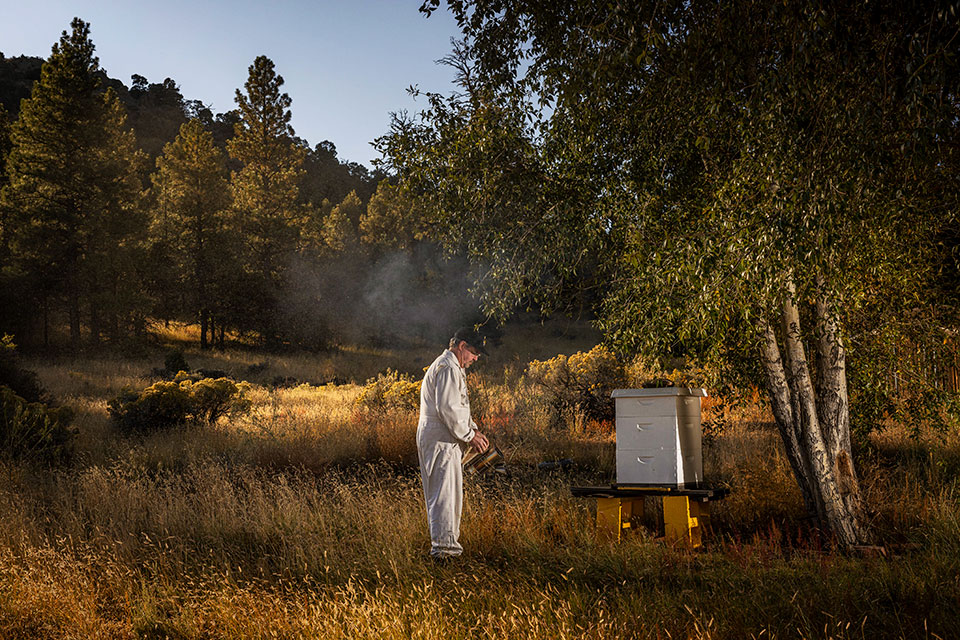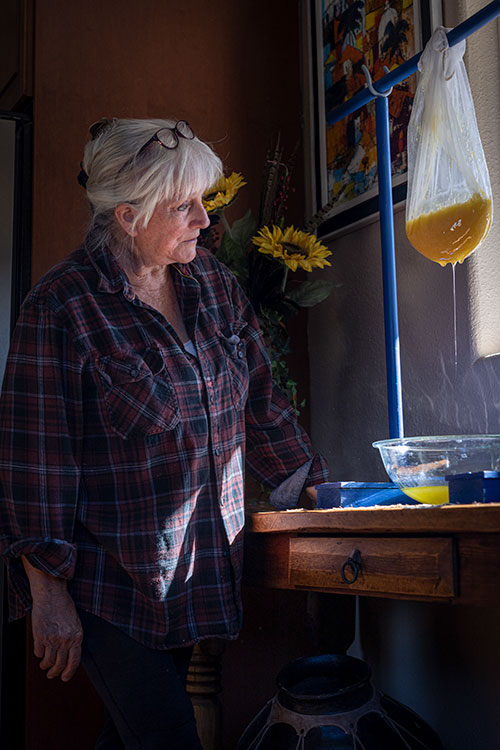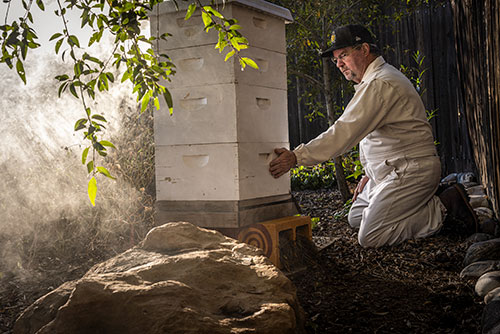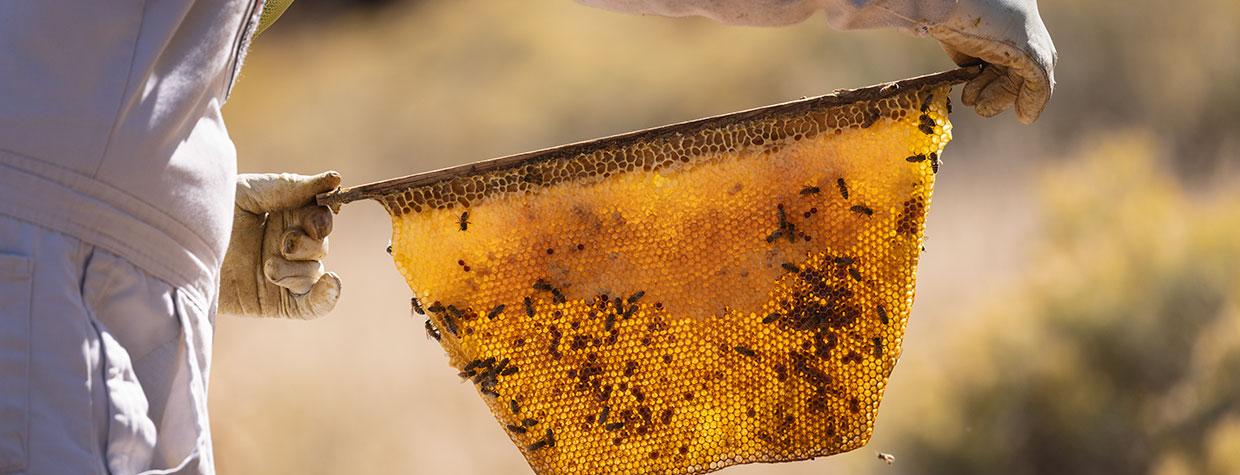Patrick Pynes and his partner, Sharon Lee Harris, live in a mountain oasis surrounded by natural beauty. Their 2.5-acre property northeast of Flagstaff offers a spectacular view of the San Francisco Peaks, sometimes shimmering with snow or a purple alpenglow. A riot of wildflowers fills the meadows in summer, and songbirds serenade the sunrise.
But what draws Pynes’ attention most days are the honeybees. He likes to sit in a lawn chair next to the hives he keeps on the property and observe them for hours. Like a detective on a stakeout, he watches the bees come and go, keeping his eyes peeled for any changes in their flight patterns or feeding habits. His objective is simple. “I want to learn to think like a bee,” he says. “They have their own way of thinking, and they adjust to their environment based on that intelligence.”
Pynes has tended honeybees in the Southwest for more than 30 years and led the Northern Arizona Organic Beekeepers Association for nearly a decade. In addition to maintaining his own hives, he mentors nascent beekeepers through classes he teaches on his property, which he calls the Center for Organic Beekeeping, and also at academic institutions and community organizations, including Prescott College and the Museum of Northern Arizona.
Pynes got into beekeeping because he loves honey, which he calls one of his “greatest weaknesses.” But over the years, his passion for beekeeping has evolved well beyond his quest for the sweet stuff. Learning to “think like a bee” has become his overarching philosophy.
“Patrick is the Buddha of the bees,” says Northern Arizona University professor Larry Stevens, who’s taken two of Pynes’ workshops and now tends hives at his own home outside Flagstaff. “Patrick does not just teach beekeeping. He integrates anthropology, ecology, sustainability and biodiversity into what he shares.”
But Pynes is quick to point out that he doesn’t consider himself a teacher. It’s the honeybees who impart the knowledge, and he simply passes it on to others. “Beekeeping is all about learning from this highly intelligent creature,” he says.
It sounds idyllic. But Pynes’ unconventional approach to beekeeping can be deadly if not done right. That’s because wild honeybees in Arizona and much of the Southwest are Africanized and inevitably infiltrate a beekeeper’s hives. Consequently, Pynes spends much of his time studying and tending these so-called “killer bees.” And while commercial beekeepers in Arizona go to great lengths to purge those bees from their hives, Pynes embraces what he describes as “locally adapted bees,” which he says are excellent honey producers. More important to him, though, is what he believes these feared insects can teach us.
“I want to be in a relationship with the bees,” he says. “Because once you understand how to do that, then you can see what the possibilities are for being in a relationship with the rest of nature.”
Pynes obtained his first honeybee hive in 1991, when he was attending college at the University of New Mexico in Albuquerque. He was earning his doctorate in American studies and figured he could save money and still feed his honey habit if he raised his own bees.
Pynes found a colony on a mesa with the help of the city’s animal control department. He shook the colony into a box — without getting stung — and took it home. An older beekeeper in Albuquerque mentored him in the early days, but mostly, he learned through trial and error, reading books and joining the New Mexico Beekeepers Association.
While Pynes’ new colony was the European honeybee (Apis mellifera), the Africanized honeybee had just made its way into South Texas and would soon drastically change the practice of beekeeping in the Southwest.

Neither Africanized nor European honeybees are native to the Americas. Before European colonizers arrived in the United States, North American plants were pollinated by some 4,000 species of native bees, as well as by moths, butterflies and bats. But as the Europeans introduced their own crops to North America, they also imported the practice of beekeeping, along with boxes of domesticated European honeybees. Everything from almonds to broccoli to apples now depends on honeybees to grow, and today’s commercial beekeepers produce honey but also often rent out their hives to farmers for pollination services.
The Africanized bee (Apis mellifera scutellata), a hybridized subspecies, first came to the Americas in the late 1950s, when beekeepers in Brazil imported honeybee queens from Africa in an attempt to help their European bees survive the harsh tropical climate. Africanized honeybees were, indeed, better adapted to warmer climates and easily outcompeted the European variety for food and mates. The hybridized bees escaped their hives in Brazil and gradually traveled north, mating with European bees along the way. Unlike the docile Europeans, Africanized bees proved to be highly defensive, attacking a potential threat en masse — behavior that earned them their “killer” nickname. The first person killed by Africanized bees in the United States was a South Texas rancher in 1993. Two years later, an Apache Junction woman, stung more than
1,000 times, became the first Africanized bee fatality in Arizona.
The bees weren’t the only new challenge for beekeepers in the 1990s. A parasitic mite had invaded the U.S. and was literally sucking the life out of European honeybees. A mite infestation could quickly kill a colony, as the honeybees had no immune defense against the parasite and the viruses it carried.
Historically, tending European honeybees had been a low-cost, low-effort endeavor, as long as the hives were in a place with plenty of flowering plants for foraging. The bees could take care of themselves. But by the 1990s, beekeeping became complicated and expensive as it started to depend on the use of chemical insecticides and antibiotics. And the only way to stop Africanized bees taking over a hive was to buy costly European queens specifically raised for artificially inserting into colonies.
Pynes and his family moved from New Mexico to Flagstaff in 2000. He was teaching at NAU, raising three young daughters and tending several honeybee hives on his property. Although Africanized bees were becoming increasingly common in Southern Arizona, beekeepers predicted the hybrids would never migrate to the colder climate of higher elevations. But Pynes was starting to suspect that would not be the case.
“When a colony would swarm or supersede its queen, the new queen and her colony would be much more defensive than any bees I had worked with before,” Pynes recalls. “I assumed that these were the killer bees but had no scientific evidence for it.”
Pynes was worried about having Africanized bees near his children, so he adhered to the popular practice of buying purebred European queens raised outside Arizona to try to keep his colonies from becoming aggressive. But Pynes also kept hives in a grassland below the Mogollon Rim, where it was warmer and more isolated. By 2010, he let the DNA of some of his hives start to drift. The Africanized hives proved to be more resilient during drought, while the European bees often starved, unable to make enough honey to keep the colony alive. As an organic beekeeper, Pynes didn’t supplement his hives with sugar patties or use chemicals to repel mites. It was survival of the fittest, and the Africanized bees won — and even produced a surplus of honey.
“Honey is important to me,” Pynes says. “After that, I became sold on the locally adapted, so-called ‘killer’ bees.”

On a sunny morning in mid-September, Pynes is checking his hives at the Center for Organic Beekeeping, which he calls “the COB.” The meadows around his house and a hog barn that’s been converted into a classroom are filled with sunflowers and other blooming plants thanks to abundant monsoon rains. Pynes’ daughters are grown, and he and Harris have turned their attention to transforming their homestead into a honeybee haven.
In addition to sunflowers, the delicate lavender flowers of the Rocky Mountain beeplant — a staple of Northern Arizona honeybees — surround Pynes’ hives. He has three Africanized colonies on the property, along with four European hives from Saskatraz honeybees, which are bred to be more resilient but can live only in cooler climates. He also keeps three Africanized colonies in a remote area in the Verde Valley.
Pynes says each of his colonies has a different character, something he learned over time from observing them. He gives each a name to remind himself “who they are” in terms of origin and temperament. The names also often reflect Pynes’ sense of humor: At last count, his extended family included the Grasshoppers, Kuyis, Ninitas, Durango 95s, Picantes, Wild Thangs and Wild Thangs 2.
The Wild Thangs are an Africanized colony that lived for years in a tree snag next to the Horsemen Lodge restaurant in Flagstaff. When the snag blew over a few years ago, Pynes was asked to remove the bees, a request he receives frequently. Rather than trying to extract the potentially aggressive colony from its long-term home, Pynes had the section of snag containing the bees sawed off and transported to his property. Wild Thangs 2 are descendants of the snag dwellers, and Pynes successfully moved them into a nearby human-made hive.
As their names suggest, these two colonies are 100 percent Africanized, and Pynes approaches them with caution. “Wild Thangs 2 were highly defensive when I first put them in the hive, although they have calmed down somewhat,” he says. “I don’t get real close, but sometimes I put my veil on and watch them.
I want to know if they’re bringing pollen to the queen and other indications about what’s going on in the environment.”
Pynes says the Africanized bees fly in a “tight zigzagging” pattern, while European honeybees have more of a looping motion. He’s also noticed over the past two decades that while some Africanized colonies are easily triggered by potential threats, others are only “moderately defensive or even not very defensive at all.”
According to the Southern Arizona Beekeepers Association, the chance of dying from an attack by Africanized bees is “several times less than getting struck by lightning.” Nevertheless, the bees are widespread throughout the Southwest and will only become more prevalent as climate change creates warmer, drier conditions. “I respect the Africanized bee and the fact that they can kill you,” Pynes says. “So can a grizzly bear. There’s nothing wrong with that. Nature is not always harmonious.”
For Pynes, working with Africanized bees is like choosing to hike in grizzly country. In exchange for tolerating the potential hazards, he’s able to tend healthy, well-adapted bees that require no chemicals, supplemental feeding or mail-order queens, even during drought. And their honey is delicious. Pynes’ students interested in organic beekeeping learn about this trade-off and techniques for tending a colony of Africanized bees.
“Patrick teaches us about how the hives can sense your energy,” says Stevens, the NAU professor. “And I have definitely experienced this. If you go out there to work with them and you are anxious and fearful, they can sense that. On the other hand, if you are easy and soft, they will be gentle.” Stevens has a hive he named the Hyperkinetics, and he assumes it’s at least partly Africanized based on how active and territorial the bees are. They survived Flagstaff’s winter last year. But a European colony he called the Zen Masters succumbed to a hard freeze.
Flagstaff resident Lindsey Watson attended a four-day workshop Pynes taught in the spring of 2021. She’d been disappointed by other beekeeping workshops, where the focus was on pumping the hives full of miticides and antibiotics. Watson’s initial draw to beekeeping was to produce locally grown honey for her family in her organic garden. “Patrick really changed my perspective,” Watson says. “Instead of focusing on honey, he inspired me to try and create a beautiful place where bees would want to live and to let them do their own thing.”

But places where honeybees can thrive are in short supply these days. According to an annual survey conducted by the nonprofit Bee Informed Partnership, 45.5 percent of managed honeybee colonies in the U.S. died over a 12-month period in 2020 and 2021 — the second-highest rate since 2006, when the survey began. Most of those hives were owned by commercial beekeepers to pollinate industrialized agricultural operations.
The beekeepers attributed the deaths to pesticide exposure, parasites and habitat loss. But Pynes says the core problem leading to pollinator decline is an imbalance in human beings’ relationship with the rest of the natural world. “The bees are being disrespected,” he says, referring to the mechanization of one of nature’s most vital and delicate processes.
Meanwhile, Pynes is making progress building a relationship with Wild Thangs 2. He’s just watching them for now and has no intention of trying to harvest their excess honey. “It’s all about communication,” he says. “Sometimes the bees say, ‘Get out of my hive.’ And I say, ‘OK.’ But other times, they are open to being in a relationship with me. To be acknowledged by this other intelligent creature is really powerful. It is a peak experience.”
Honeybee Safety
Assume that any “wild” Arizona honeybee colony — meaning one not managed by a beekeeper in a human-made hive — is Africanized. Wild honeybees often are found living under shed floors, in the corners of patio overhangs and inside water meter or irrigation boxes. They also live in tree snags, in saguaro cavities and under rock ledges. If you discover a honeybee colony around your home, call a professional pest control service or beekeeper to have it removed. Do not try to remove the colony yourself, as you will likely provoke the bees.
Africanized bees are very sensitive to ground vibrations, and many people who have been attacked were operating a lawn mower or tractor near a colony. If a few honeybees fly close to your head, it means they’re checking you out as a potential threat and may summon the rest of the colony to attack. Calmly walk away from the area. If you must pass by a colony, keep at least 100 feet between yourself and the bees so they don’t feel threatened.
If bees attack you, cover your nose and mouth with your hands or clothing and, if possible, run through dense vegetation to disperse the bees. More preferably, get into an enclosed space such as a building or car, even if some bees come inside with you.
Sources: Southern Arizona Beekeepers Association and Patrick Pynes

